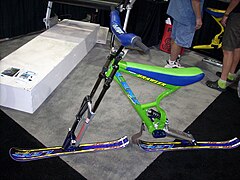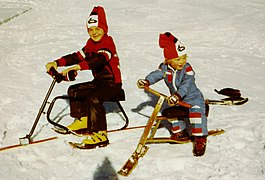
Skiing is the use of skis to glide on snow for basic transport, a recreational activity, or a competitive winter sport. Many types of competitive skiing events are recognized by the International Olympic Committee (IOC), and the International Ski and Snowboard Federation (FIS).

Winter sports or winter activities are competitive sports or non-competitive recreational activities which are played on snow or ice. Most are variations of skiing, ice skating and sledding. Traditionally, such games were only played in cold areas during winter, but artificial snow and artificial ice allow more flexibility. Playing areas and fields consist of either snow or ice.

Water skiing is a surface water sport in which an individual is pulled behind a boat or a cable ski installation over a body of water, skimming the surface on two skis or one ski. The sport requires sufficient area on a stretch of water, one or two skis, a tow boat with tow rope, two or three people, and a personal flotation device. In addition, the skier must have adequate upper and lower body strength, muscular endurance, and good balance.

Alpine skiing, or downhill skiing, is the pastime of sliding down snow-covered slopes on skis with fixed-heel bindings, unlike other types of skiing, which use skis with free-heel bindings. Whether for recreation or for sport, it is typically practiced at ski resorts, which provide such services as ski lifts, artificial snow making, snow grooming, restaurants, and ski patrol.

Mont Ventoux is a mountain in the Provence region of southern France, located some 20 km northeast of Carpentras, Vaucluse. On the north side, the mountain borders the department of Drôme. At 1,910 m (6,270 ft), it is the highest mountain in the region and has been nicknamed the "Beast of Provence", the "Giant of Provence", or "The Bald Mountain". It has gained fame through its inclusion in the Tour de France cycling race; in 2009 it was the scene of the first penultimate-day mountain top finish in the Tour de France, with Alberto Contador sealing his yellow jersey.

A recumbent bicycle is a bicycle that places the rider in a laid-back reclining position. Recumbents are available in a wide range of configurations, including: long to short wheelbase; large, small, or a mix of wheel sizes; overseat, underseat, or no-hands steering; and rear wheel or front wheel drive. A variant with three wheels is a recumbent tricycle.

A tricycle, sometimes abbreviated to trike, is a human-powered three-wheeled vehicle.

Mountain biking is a sport of riding bicycles off-road, often over rough terrain, usually using specially designed mountain bikes. Mountain bikes share similarities with other bikes but incorporate features designed to enhance durability and performance in rough terrain, such as air or coil-sprung shocks used as suspension, larger and wider wheels and tires, stronger frame materials, and mechanically or hydraulically actuated disc brakes. Mountain biking can generally be broken down into distinct categories: cross country, trail, all mountain, enduro, downhill and freeride.
Cycle sport is competitive physical activity using bicycles. There are several categories of bicycle racing including road bicycle racing, cyclo-cross, mountain bike racing, track cycling, BMX, and cycle speedway. Non-racing cycling sports include artistic cycling, cycle polo, freestyle BMX, mountain bike trials, hardcourt bike polo and cycleball. The Union Cycliste Internationale (UCI) is the world governing body for cycling and international competitive cycling events. The International Human Powered Vehicle Association is the governing body for human-powered vehicles that imposes far fewer restrictions on their design than does the UCI. The UltraMarathon Cycling Association is the governing body for many ultra-distance cycling races.

Downhill mountain biking (DH) is a style of mountain biking practiced on steep, rough terrain that often features jumps, drops, rock gardens and other obstacles. Jumps can be up to and including 12 meters, and drops can be greater than 3 meters.

In the market, there is a wide variety of types of motorcycles, each with unique characteristics and features. Models vary according to the specific needs of each user, such as standard, cruiser, touring, sports, off-road, dual-purpose, scooters, etc. Often, some types like sport touring are considered as an additional category or integrated with touring.

Mountain bike racing is the competitive cycle sport discipline of mountain biking held on off-road terrain. The Union Cycliste Internationale (UCI) recognised the discipline relatively late in 1990, when it sanctioned the world championships in Durango, Colorado. The first UCI Mountain Bike World Cup series took place in 1988. Its nine-race circuit covered two continents—Europe and North America—and was sponsored by Grundig. Cross-country racing was the only World Cup sport at this time. In 1993, a six-event downhill World Cup was introduced. In 1996, cross-country mountain biking events were added to the Olympic Games. In 2006, cross-country mountain biking events became part of the World Deaf Cycling Championships for the first time in San Francisco, USA.

A motorized bicycle is a bicycle with an attached motor or engine and transmission used either to power the vehicle unassisted, or to assist with pedalling. Since it sometimes retains both pedals and a discrete connected drive for rider-powered propulsion, the motorized bicycle is in technical terms a true bicycle, albeit a power-assisted one. Typically they are incapable of speeds above 52 km/h (32 mph); however, in recent years larger motors have been built, allowing bikes to reach speeds of upwards of 113 km/h.
Many countries have enacted electric vehicle laws to regulate the use of electric bicycles, also termed e-bikes. Some jurisdictions have regulations governing safety requirements and standards of manufacture. The members of the European Union and other regions have wider-ranging legislation covering use and safety.
The following outline is provided as an overview of and topical guide to transport:
Horseshoe Valley Resort, formerly Horseshoe Valley Ski Club, is an Ontario ski resort and four season vacation destination. Located north of Barrie, the resort is 110 km north of Toronto. The resort enjoys a long ski season due to snowmaking abilities. Acquired by Freed Hotels and Resorts in 2021, Horseshoe Resort is spread out over 680 acres (280 ha) of land. The resort offers 29 ski runs, over 30 kilometres of Nordic trails, 18-hole Valley golf course, Amba Spa, 101 rooms at the on-site inn, 40 condo-style suites, two year-round restaurants, 16,000 square feet (1,500 m2) of meeting and banquet facilities, indoor and outdoor swimming pools, a full gym, and over 25 miles (40 km) of trails connected to the Copeland Forest suitable for hiking, biking and snowshoeing.

Sunrise Park Resort is an alpine ski resort located near Greer, Arizona. The resort consists of three mountains named Sunrise Peak, Cyclone Circle, and Apache Peak. Situated on the Colorado Plateau and perched atop the White Mountains in eastern Arizona. The base of the resort sits at 9,200 feet (2,800 m) and the tallest mountain, Apache Peak, tops out at an elevation of 11,100 feet (3,400 m) above sea level. The ski slopes spread across the 3 peaks and cover 1,200 acres (4.9 km2), making it the largest ski resort in Arizona.

Mixed terrain cycle touring is the practice of cycling over a variety of surfaces and topography on a single route, with a single bicycle. The recent popularity of mixed terrain touring is in part a reaction against the increasing specialization of the bike industry.

Drift trikes are tricycles with low-traction rear wheels made of hard plastic, usually PVC. They are designed for intentional drifting by initiating a loss of traction on the rear wheels and using counter-steering. Drift trikes are typically ridden on paved roads with steep grades and corners.

Cold-weather biking, cold-weather cycling, or winter biking is the use of a bicycle during months when roads and paths are covered with ice, slush and snow. Cold weather cyclists face a number of challenges in near or below freezing temperatures. Urban commuters on city streets may have to deal with "[s]now, slush, salt, and sand", which can cause rust and damage to metal bike components. Slush and ice can jam derailleurs. Some cyclists may bike differently in winter, by "slow[ing] down on turns and brak[ing] gradually" in icy conditions. Gaining traction on snow and ice-covered roads can be difficult. Winter cyclists may use bikes with front and rear fenders, metal studded winter tires and flashing LED lights. Winter cyclists may wear layers of warm clothes and "ea[r], face, and han[d]" coverings may be used. Specialized winter bikes called fatbikes, which have wide, oversized tires that are typically inflated with low pressure, are used in snow trail riding and winter bike competitions.



















